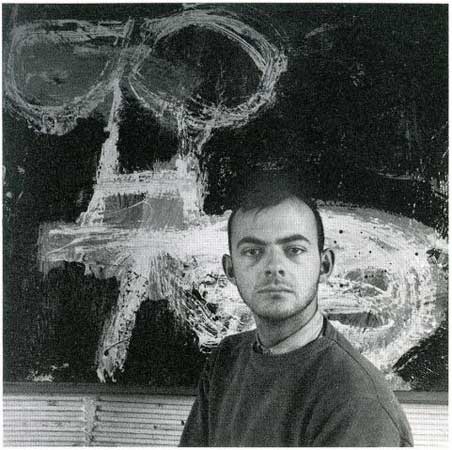 |
| Cy Twombly |
Cy Twombly is the only graffiti artist I care about
Twombly is the thinking person's Banksy. Are you ready for the real thing?
by Jonathan JonesTHE GUARDIAN
Tuesday 3 June 2008

Cy Twombly defies every category and transcends every cliché. Photograph: Francois Halard
Being a professional art critic is a truly indulged existence. You get paid to do something you'd gladly do for free, and on top of that you get free travel, free art books ... it's an art lover's heaven. And yet in every paradise there is a thorn. The thorn of being an art critic in modern Britain is that people keep asking you about Banksy.
I've published more articles about this unimportant graffiti and street artist than I care to count. I've generally been pretty harsh and yet the honest truth is that I don't have an opinion about Banksy. I can't believe that grown people find his work worth more than passing attention; he just doesn't come onto my radar. What I really want to say to his admirers is - haven't you people ever heard of Cy Twombly? He's the only graffiti artist I care about.
Twombly started scribbling and doodling on his canvases half a century ago and his retrospective that opens soon at Tate Modern is a victory march by the greatest artist alive. He is a painter - and sculptor - who defies every category and transcends every cliché: a man who has never been pinned down and is still working, at 80, with tremendous gusto and creative generosity. Nor has he retired into a world of his own. His recent paintings, which lusciously contemplate the beauty of Arabic script in what might be called a gesture of subversive orientalism, constitute perhaps the most intelligent response by an artist to the world's current crisis.
Banksy is a thick person's idea of a radical artist. Twombly is a thinking person's. He began scrawling on his paintings in the 1950s when the presiding genius of modern art was Jackson Pollock. The idea of the abstract painterly mark as "writing" is already there in Pollock, but it was Twombly who made this idea explicit. Ever since he has painted grand, brave works that are at once abstract and literary, that demand to be read while also being hard, perhaps impossible, to read. This makes him sound difficult, and he is, but his work has a sensuality that is immediately, humanly rewarding.
His use of graffiti means being alive to what it represents - the dirty life of the street. You think young urban artists are alive to the chaos and energy of the city? Take a look at Twombly's 1961 painting Triumph of Galatea. On this canvas, nearly five metres wide, hedonist smears of sensual abandon spatter across white space - a pair of pink breasts, drawn as crudely as if they were on the door of a public toilet, float among scratchy pencil marks, urine-coloured paint smears and many varieties of fleshy daubing. The sexy, crass, immediate tang of real life is all over this painting, but it is also a homage to Raphael's fresco of the nymph Galatea in the Villa Farnesina in Rome. The painting of a beautiful mythological being sailing over the waves on a gigantic shell surrounded by tritons and sea nymphs is a triumphant Renaissance depiction of nature in harmony, a perfect idyll. Twombly's version is far more violent, dangerous and distracted. Desire does not unify; it disperses.
The most confounding move in this great American's never predictable career was to emigrate to Europe, and the city at the centre of his life as an artist is Rome - he is the greatest painter of the city since Turner. His art mirrors its amazing mix of high and low, grand and grotesque, beautiful and corrupt. He is the only artist today who works naturally in - critical - conversation with the greats of art history, casually mixing the demotic language of graffiti art with erudite allusion.
Have I succeeded in putting you off? I'm sorry to pick on poor little Banksy - but does art have to be stupid, vulgar, trite and obvious? Is that all people can relate to? Tate Modern - rarely short of a bit of publicity - admits it has been surprisingly hard to secure press coverage for Twombly. And yet he has everything: sex, graffiti, baroque energy and seductive beauty. He is a genius - and he's alive and working now! Will this important exhibition pull the crowds, or are people more interested in the latest glib posturing by a 40-something British art star who will be forgotten in a few years? What's it to be, all you Britons so proud that you've discovered modern art? Are you ready for the real thing?
Untitled 2007, from the series A Scattering of Blossoms. 'I work in waves, because I'm impatient'
Untitled, Part VII, 1988. Oil and water-based paint on wood panel. 'I'm not too sensitive to colour, not really'
Ferragosto V, 1961. Oil paint, wax crayon, lead pencil on canvas. '[The Ferragosto paintings] were done in Rome, when I had to stay there in August. I was completely crazy, out of my mind with [the] heat'
Bacchus series: Untitled VII, 2005. Acrylic on canvas. 'These were all done in a couple of months. It was just very physical'
Coronation of Sesostris, 2000. 'I managed to do very childlike painting, very immediate'

Cy Twombly at Black Mountain College, North Carolina in the 50s. 'It was the first time I'd been in an atmosphere of artsy-ness'







No comments:
Post a Comment